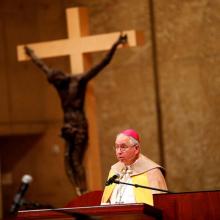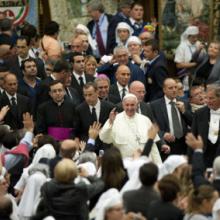Francis Effect
A week after Donald Trump’s stunning election as president sent the country’s governance lurching to the right, the nation’s Catholic bishops sent a message of their own — at least on immigration — by putting Mexican-born Archbishop Jose Gomez of Los Angeles in line to become the first Latino to lead the American hierarchy.
But the vote at their annual fall meeting in Baltimore on Nov. 15 also suggested that the U.S. Conference of Catholic Bishops is still hesitant to fully endorse the more progressive and pastoral approach to ministry that Pope Francis has been championing since his election in 2013.

Image via David Gibson / RNS
The nation’s Catholic bishops on Nov. 17 passed an updated guide for Catholic voters ahead of next year’s elections, but only after airing unusually sharp disagreements on how much they can, and should, adjust their priorities to match those of Pope Francis.
More than any other item on the agenda of the bishops’ annual meeting here, the debate over the lengthy voter guide, called “Faithful Citizenship,” revealed deep divides among the bishops and provided a snapshot of the extent of the “Francis effect” on the U.S. hierarchy.
In the most impassioned objection to the voter guide, San Diego Bishop Robert McElroy took the floor to argue that the document — which was a reworking of an 84-page treatise first written in 2007 — should be scrapped because it did not reflect the way that Francis has elevated the battle against poverty and for the environment as central concerns for the Catholic Church since his election in 2013.

Image via Ivan Cholakov/Shutterstock
Next week, the conversation will change in America. All the media attention recently given to political figures will now shift to a moral leader who is changing the global public discussion about what is compassionate, just, good, and right — and Christian.
This is a fundamental spiritual shift that we deeply need in our country right now. Three major East Coast cities will have their typical traffic patterns and lodging arrangements severely disrupted. I’m not predicting an earthquake or a hurricane — instead, for only the tenth time in our nation’s history , the pope, spiritual leader of 1.2 billion Roman Catholics worldwide, will visit the United States.
The last papal visit was from Pope Benedict XVI in 2008. Pope Francis’ visit to Washington, D.C., Philadelphia, and New York City, which will take place from September 22-27, is expected to be historic in terms of the crowds it generates, with well over one million people anticipated for the Philadelphia portion alone.
Pope Francis appears more popular than ever among American Catholics, and he hasn’t even visited the U.S. yet, a trip that is planned for September and could well boost his visibility — and appeal — even further.
But will Francis find American Catholics filling the pews? Or just loving the pope from afar? That’s one of the big — and so far unanswered — questions about his remarkable papacy.
Now, one researcher may have found some signs, albeit tentative, of an incipient “Francis effect.”
Mark Gray of Georgetown University’s Center for Applied Research in the Apostolate crunched the Catholic numbers from the 2014 General Social Survey, the go-to resource for sociologists. The GSS began in 1972 and is conducted every two years using face-to-face interviews with a national random sample of adults.
Gray noted that when asked to characterize the strength of their religious affiliation, 34 percent of Catholics said it was “strong,” up from 27 percent in 2012, the year before Francis was elected.
That 7-point rise was a “significant bounce,” Gray said.
As investments go, this was a good one.
A Harley-Davidson motorcycle briefly owned by Pope Francis sold Thursday for $325,000, more than 25 times the Kelley Blue Book resale value for a similar bike.
Chalk it up to the so-called Francis Effect — credited for everything from increased church attendance in Italy to a surge of tourists arriving in Rome from the pope’s native Argentina. Now, evidently, it dramatically changes the value of objects the pope once owned.
First, the name “Francesco” leapfrogged to No. 1 on the list of the most popular baby names in Italy.
Then, the city of Rome reported a tourism boom, mostly from Latin America.
Now, there’s word Roman Catholic Church attendance is climbing throughout Italy.
Blame it on “the Francis effect.”
Italy’s Center for Studies on New Religions reported Sunday that around half of the 250 priests it surveyed reported a significant rise in church attendance since Cardinal Jorge Mario Bergoglio became Pope Francis in March.
When the nation’s Catholic bishops gather on Monday for their annual fall meeting in Baltimore, one of their chief duties will be choosing a new slate of leaders to guide the American hierarchy for the next three years.
But the more than 200 prelates will also be looking over their heads — and maybe their shoulders — to the Vatican to gauge what Pope Francis’ dramatic new approach means for their future.
If Francis has made one thing clear in his nearly nine months on the job, it is that he wants the church to radically change its tone and style, starting at the top. The pontiff has repeatedly blasted careerism among churchmen and ripped “airport bishops” who spend more time jetting around the globe — and to Rome — rather than being pastors who go out to their flock and come back “smelling of the sheep,” as he likes to put it.




